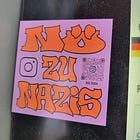What's Left in Friedrichshain?
Despite its current reputation as a place to party, elements of the district's left-wing, working class history remain
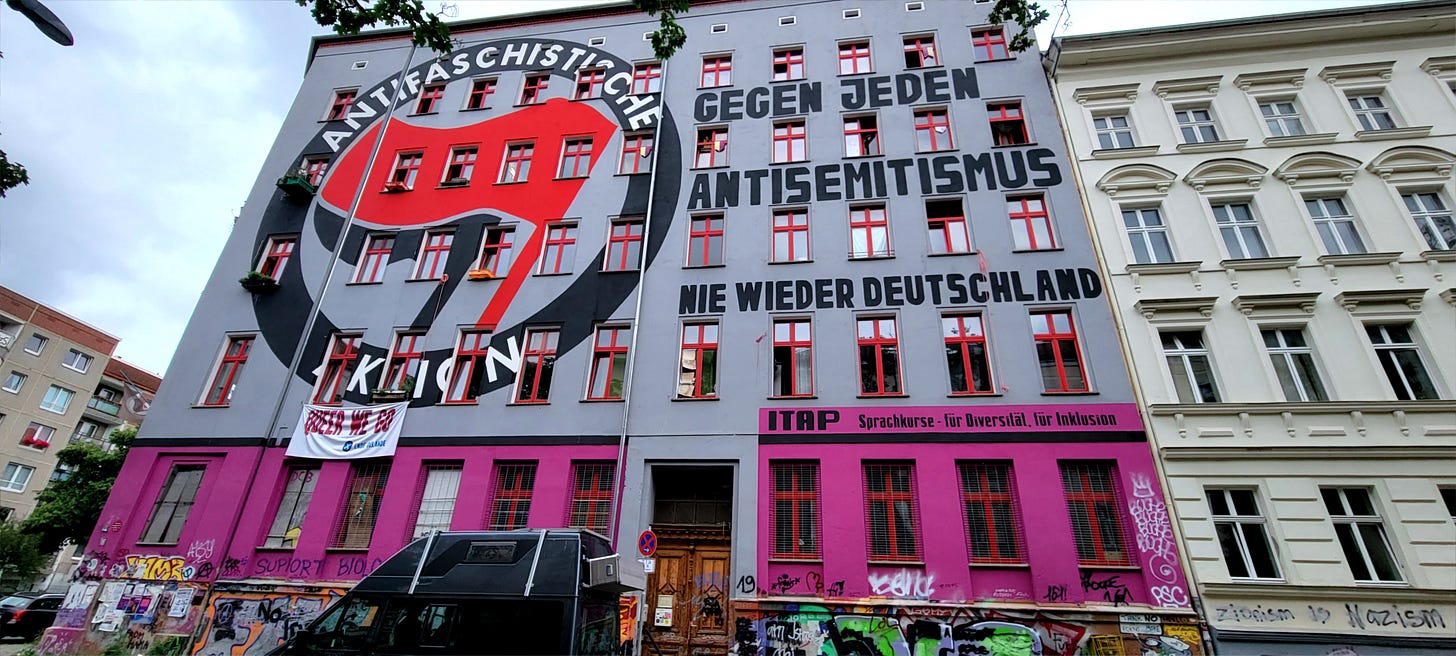
In an earlier article about the far-right demos held in our area, I mentioned Friedrichshain’s long history and reputation as a center of left-wing political and social action.
The neo-Nazis don’t choose to march here because they think they’ll see friendly faces. They do it because they know they won’t.
It’s a show of defiance and provocation - sort of demonstrating how tough they are (or aren’t), I guess.
The city district was formed in the late 19th century during the rapid industrialization of Berlin and the founding of the German Empire (this is known as the Grunderzeit in German, for “founding time/era”).
What would become the urban bezirk of Friedrichshain was an amalgamation of smaller farms, towns and suburbs that were quickly transformed into factories, warehouses, slaughterhouses, and a large port. It would also soon be home to the city’s first municipal gas works and waterworks and the tenement housing that the employees of all of these places would live.
Industrial workers in Friedrichshain began many of Berlin’s popular movements and demonstrations for the interests of working people—for improved housing conditions, organized labor, and resistance to authoritarianism—first in opposition to the empire and, later, to National Socialism then the autocratic government of East Germany.
In recent decades, as the factories closed and the district gentrified following German re-unification, Friedrichshain has become popular as the home of trendy bars, pubs and clubs. (Although the rising rents are now threatening the club scene.)
But Friedrichshain is about much more than Berghain and Simon Dach Strasse. Here are some of what is still “left” in Friedrichshain.
Karl Marx Allee
It probably doesn’t get more “left wing” than a major boulevard named for Karl Marx.
The thoroughfare stretching from Strausberger Platz to Frankfurter Tor was known as Stalinallee during the time of the DDR and named after Marx following reunification.
During the country’s division, the boulevard was the flagship street of East Berlin. Because most of the buildings on either side had been destroyed during World War II, they were replaced with huge seven- to nine-story residential buildings in the Stalinist neo-classical style of the 1950s.
The plaza area around Frankfurter Tor has been the site of several popular uprisings, even before it was named in honor of the philosopher. Between June 25-27, 1872, some of the street battles of the Blumenstrasse Riots - a “struggle between factory workers, journeymen, and homeless people” and the Berlin police over high rents and the high number of evictions - were fought here.
The building sites along the Allee also became the focus of the anti-government demonstrations held on June 17, 1953—when more than a million East Germans in 700 cities and towns all over the country took part in protests demanding free elections and improved working conditions.
At its peak on June 17, all major cities, most district capitals and large parts of the smaller towns and villages were affected. The largest protests and riots took place in East Berlin , Merseburg and Halle (Saale) .
…
The Soviet occupying forces violently ended the uprising using Soviet Army troops with the participation of GDR police forces. [ 5 ] The suppression was "one of the largest military operations in post-war European history." [ 11 ] Over 50 insurgents were killed by Soviet soldiers or GDR security forces, or sentenced to death by the Soviet or GDR judiciary.
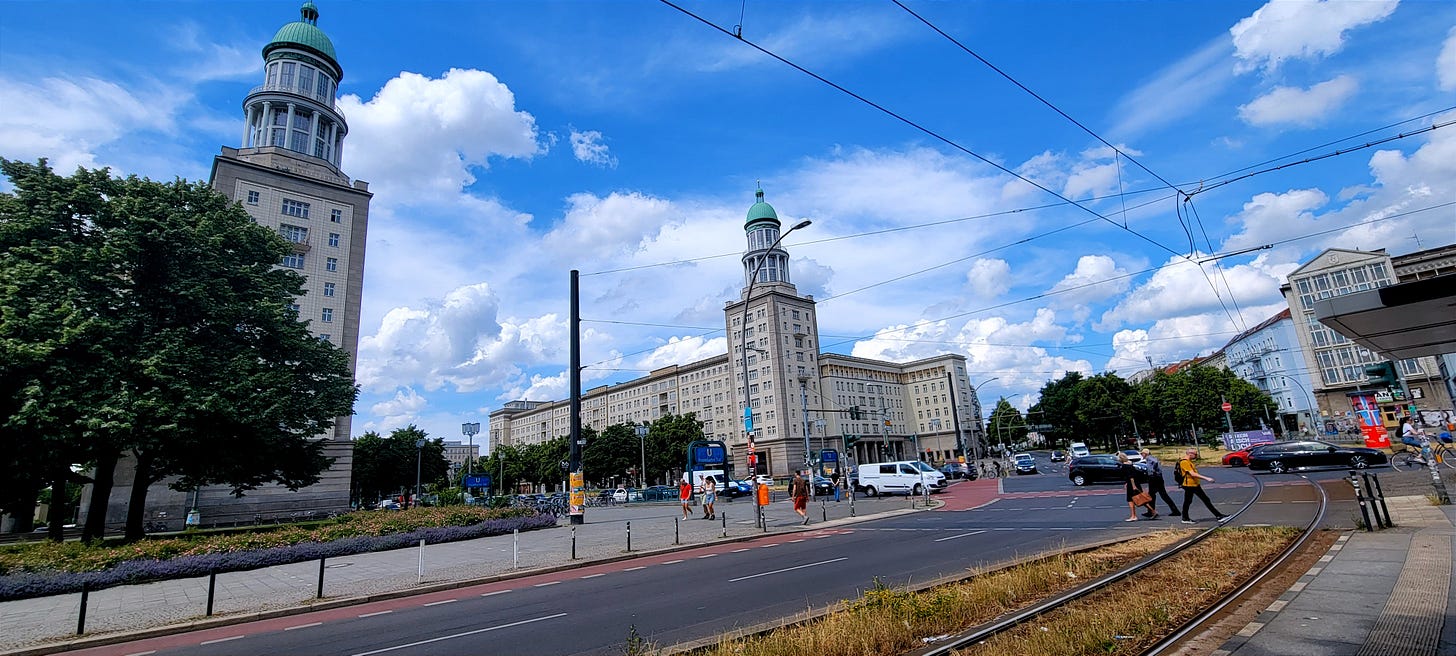
R.A.W. Gelände
When I first moved here, I kept referring to the open industrial event space by Warschauer Strasse as the “Raw,” thinking it was named that for the somewhat rough aesthetic of the different nightclubs and art installations that currently occupy it.
Actually, I don’t think I referred to it this way out loud, at least not to anyone in public - which is good. Because R.A.W. is not an English acronym, and its name is the three individual letters pronounced separately, in German — R, A, W (err, ah, vay).
The letters stand for the site’s original name and purpose, the Reichsbahnausbesserungswerk (the state railway repair shop).
Opened in 1867 as the Royal Prussian Railway Worship Berlin II, the facility was used by the Prussian Railway and its successor, the Reichsbahn, to repair and maintain locomotives as well as passenger and freight cars. At the height of operations, more than 1,200 people were employed there.
The site stopped being used by Deutsche Bahn in 1991 and its shops were gradually decommissioned, with all operations ceasing in 1995. (A Spanish rail company, Talgo, still has a paint shop operating on part of the property.)
In the late 1990s, artists began taking over different parts of the empty industrial site for the purpose of creating an open socio-cultural space for “self-expression and solidarity.”
Together, they eventually formed an non-profit association to manage the site collectively.
Today, many of the different artist galleries, entertainment venues, and cultural offerings are governed by means of democratic self-management, meaning that the users of these facilities organize themselves in plenaries, which meet in delegate assemblies and working groups to address issues of concern regarding the site as a whole.
The land itself is privately owned—by four different property owners—and the different cultural and artists associations now have lease agreements directly with their individual landlords.
Over the years, different private real estate interests have tried to re-develop the site into a residential and commercial district, but those efforts have been mostly unsuccessful.
Since 2015, the Kurth investment group has owned much of the property and has initiated a more collaborative effort to redevelop the R.A.W., seeking input from the residents of the surrounding neighborhoods and the owners and directors of the site’s current occupants in order to develop a master plan for redevelopment.
“Some of the key issues that have been addressed or will be addressed range from citizen engagement to the creation of lively places for neighbourhood exchange, from the retention and expansion of cultural free spaces to achieving climate resilience via a coherent landscape architecture concept – which, among other things, seeks to minimise paved area and provide more publicly accessible green space – as well as the retention of public transit connections as a key aspect of Germany’s Mobilitätswende, or “mobility turn”.”
—Kurth Group. A vision for the R.A.W. site. Accessed April 30, 2025.
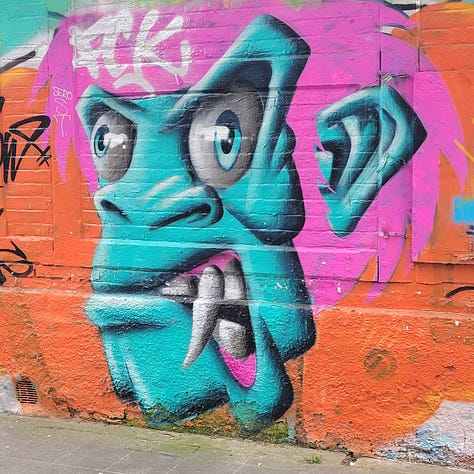
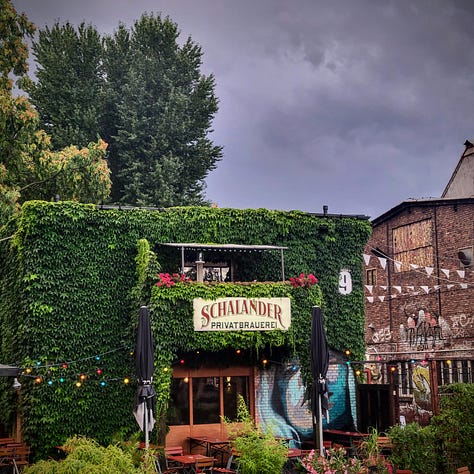
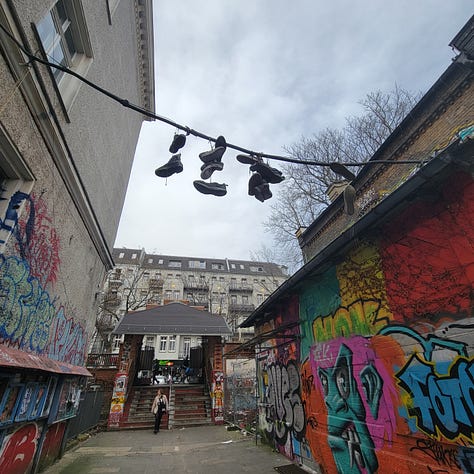


Rigaer94
The apartment building at Rigaerstrasse 94 is a former east Berlin “squat” that is still engaged in disputes with the owner of the property and the city over tenants’ right to remain.
Beginning in the 1970s, squatters occupied many abandoned apartment houses in economically depressed areas of west Berlin. This movement expanded into east Berlin with the fall of the Berlin Wall.
As thousands of people fled the former East Germany for better economic prospects in the west, they left a largely unregulated landscape of empty apartment buildings and commercial spaces.
Under the GDR/DDR, housing was owned by the state and administered by local housing authorities. With the demise of the state, thousands of properties were left in a legal limbo for years. The districts of Friedrichshain, Prenzlauer Berg, and Mitte, in particular, were then poor districts with little economic investment.
People either not able to afford a rental contract in ‘regular’ buildings or who wanted to set up alternative ways of living began to take over abandoned buildings in these districts.
The building at Rigaer 94, along with several others nearby, was first occupied in 1990. Nominally, the property was owned by the Berlin government, which was converting the former housing cooperatives to municipally owned associations.
Beginning in 1992, the public housing association began putting the residents on individual rental contracts, with the tenants at Rigaer 94 beginning to pay rent in 1996.
But in 1997, the public authority sold the building (along with three others) to a private company. The private owners wanted to put the tenants on new, more expensive contracts, and initiate more direct control over use of the building.
(The bar, Kadterschmiede, on the ground floor, for example has operated without a lease since the end of 2013.)
The other former squats in the area were gradually emptied, with residents either evicted or accepting new contract terms. But the tenants at Rigaer continued to fight in — and out —of court.
Through the early 2000s and 2010s, disputes between the tenants and the property’s new owners have resulted in several rounds of eviction proceedings, with courts ruling for the tenants in some cases and for the property owner in others.
Residents have resisted attempts by the city to initiate building inspections and by the owner to implement renovations or other changes to the property.
In 2014, the building was sold again, to a new owner who has remained anonymous, but represented by a London-based investment company.
After several court decisions that favored the tenants, the new owners have recently succeeded in getting more eviction orders granted, and many of the tenants have indicated they are tired of fighting.
So, while Friedrichshain’s last squatted house may not last for long, for now, Rigaer 94 remains.
Learn More: Squat Houses in Berlin
Ciannait Khan. Inside Berlin’s Former Squats. University Times Magazine. January 12, 2019.
SystemFehler
The colorful front of the apartment house at Jessnerstrasse 41 facing the Traveplatz is covered with ivy and colorful artwork and proudly displays a large sign that reads: “Kapitalismus tötet.” (Capitalism kills.)
I haven’t been able to find anything out about the house, but I am familiar with the shop on the ground floor. Named “SystemFehler” (System Error), it was designed “as a political project that – intended to be a platform for solidarity economy – offers space for events from politics, art & culture, e.g. reading circles, language courses, information events [and] art projects.”
During the weekdays, they accept donations for their gift shop that allows customers to shop for items they need without cost. The organizers of the gift shop explain their philosophy in this video on YouTube (in German with subtitles).
You can also find a list of upcoming events at the shop (game cafes, upcycling workshops, and vegan solidarity are some examples) here.
Laster und Hängerburg
The Laster und Hängerburg (the name translates to ‘Truck and Trailer Castle’) is a caravan community that has occupied an empty lot along Modersohnstrasse near Revalerstrasse since September of 2001.
According to a description on their website: “We are around 20 adults and 11 children and teenagers. We're always joined by a few guests. We live in converted trucks, vintage cars, circus trailers, construction trailers, and caravans, because that's how we like it. We share our large kitchen trailer, the office trailer, and the community trailer. We also have a guest trailer. Over the years, it has been occupied by people from all over the world.”
Originally formed in 1996 on the then-undeveloped lots at 16-18 Am Friedrichshain, the group had to leave when the property changed hands. They were on the streets for six months before finding their current site.
The residents are an integral part of the surrounding neighborhood. In the spring and summer months, they open their site each Wednesday for a communal low-cost evening meal that is cooked and served by volunteers.
Over the years, they have become pioneers of living a low-impact, environmentally conscious lifestyle and often sponsor workshops to educate others on the practical use of solar energy, small urban gardening, and other topics.
Their open-air cinema hosts screenings by up-and-coming independent filmmakers.
Community leaders note that they comply with all local residential laws and requirements, including separating their garbage and paying to have it collected by BSR. Unlike some wagen groups, they do have working toilets and showers.
“We have to procure our own fuel, carry our water in canisters to our vehicles, and even defrost the taps in winter,” it states. “We manage our daily lives through solidarity, allowing us to live an alternative lifestyle by consciously limiting ourselves to the essentials.”
Learn More: Berlin’s Caravan Sites
Charlotte Tornow. This is how people live Berlin’s wagenburg settlements. Mit Vergnügen. [Translated from the German.]
What Else?
These are just some of the more ‘left-wing’ projects in Friedrichshain that I am aware of.
Apart from Rigaer94, which expressly calls itself left-wing, I don’t know how the organizers of the other groups identify politically. But, for me, they represent the efforts of ordinary people to organize collectively for the greater good, using shared decision-making to help each other and to build sustainable communities outside of capitalist structures dependent on money and profit.
If you know of others I’ve missed, leave a comment and share.



